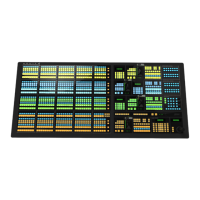Chroma Key
An UltraChrome
™
Chroma Key is a key in which the
hole is cut based on a color value, or hue, rather than a
luminance value or alpha signal. The color is removed
and replaced with background video from another source.
Chroma Key Modes
The UltraChrome Chroma Key operates in one of two
modes, Basic or Advanced, depending on the complexity
of the Chroma Key you are setting up.
• Basic — UltraChrome provides a simple
background/foreground chroma key with adjustment
for background spill and edge softness.
• Advanced — UltraChrome provides advanced
background shadow and translucency control, as well
as control over background/foreground transition
areas.
Although it is possible to switch back and forth between
advanced and basic mode, the additional image correction
of the advanced mode is only applied in the advanced
mode. For example, if you use the basic mode to set up
the Chroma Key and then switch to the advanced mode,
the entire image may change as the image correctors
provided by the advanced mode are applied at their
default settings.
From the Personality menu, you can set UltraChrome to
always start in one of these modes.
To Set Up a Chroma Key in Basic Mode
Tip: Once you have set up the chroma key how you want it to
appear, you can press and hold CHROMA KEY and press the
KEY MEM button to store these settings. Pressing the KEY MEM
button again will recall these setting for the chroma key.
1. Press the SEL button on the Keyers module for the
key you want to set up and select a video source on
the Key bus.
Tip: The SEL button allows you to quickly select the keyer
you want to work with and assign the Key bus to the keyer.
On the Double-Down control panel, the top button row is
assigned to the even numbered keyers (2,4,6,8) and the
button row below is assigned to the odd numbered keyers
(1,3,5,7). This can be changed with the DD Key Delegation
personality option.
2. Press CHROMA KEY.
3. Use the Key Mode knob to select Basic.
4. Use the Color knob select the color you want to key
out. This is the background color of your Chroma
Key that will be replaced.
From the Personality menu, you can change the
default color that UltraChrome uses.
5. Press Initialize Key.
Note: Every time the key is initialized, the switcher resets
all the Chroma Key parameters to their default settings.
6. Press Background and use the Gain knob to adjust
the background gain.
• Increasing the gain value causes the background
to appear more opaque. This results in less of the
background color being removed.
• Decreasing the gain value causes the background
to appear more transparent. This results in more
of the background color being removed.
7. Press Foreground and use the Clip, Hue, and
Reject knobs to adjust the colors used in the
foreground image.
• Clip — adds or removes lower-saturated colors
from the foreground image.
• Hue — select the central, or base, color for the
foreground image. Increasing the hue value
moves counter-clockwise around the color wheel,
and decreasing the Hue value moves clockwise
around the color wheel.
• Reject — include or reject hues adjacent to the
base color. Increasing the reject value decreases
the amount of adjacent hues that are included in
the foreground and decreasing the reject value
increases the amount of adjacent hues that are
included.
R
M
Y
G
C
B
The Hue knob rotates
the selection around
the color wheel
The Reject knob expands
and contracts the range
of hues included in the
foreground
The Spill Supress knob
expands and contracts
the range of hues that
are corrected for
background color spill
The Clip knob includes
and removes varying
saturation levels of the
hue selection
Figure 18: Effects of Clip, Hue, and Reject
8. Press Spill Suppress and use the Range knob to
adjust the amount of background color that is spilling
over into the foreground (green color cast on the
foreground from a green screen for example).
• Increasing the range value causes more of the
foreground colors to be corrected for background
color spill.
• Decreasing the range value causes fewer of the
foreground colors to be corrected for background
color spill.
Acuity Operation Manual (v9.2) — Keying • 47

